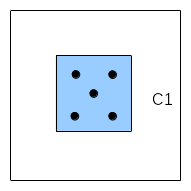1. Reference problem#
1.1. Geometry#
We consider a reinforced concrete beam with a square cross section, composed of two sections of 10 meters in length, having respectively one and four square meters in cross section. The beam is vertical, with the smallest cross section at the bottom. It is embedded at its base, and contains 5 rectilinear pretension cables. The five cables that cross the entire length of the beam are located as shown on the map below:
The cross section of each cable is \(25{\mathrm{cm}}^{2}\).


Figure 1: description of the mesh used
1.2. Material properties#
Concrete material constituting the beam:
|
\({E}_{b}=4.{10}^{4}\mathit{MPa}\) |
|
\(\mathrm{\nu }=\mathrm{0,2}\) |
|
\(\mathrm{\rho }=2500\mathit{kg}/{m}^{3}\) |
Steel material constituting the cable:
|
\({E}_{c}=\mathrm{1,93}{10}^{5}\mathrm{MPa}\) |
|
\(\mathrm{\nu }=\mathrm{0,3}\) |
|
\(\mathrm{\rho }=7850\mathit{kg}/{m}^{3}\) |
Characteristics concerning cable tension:
anchor recoil: \(1\mathrm{mm}\)
linear coefficient of friction: \(\mathrm{0,0015}{m}^{-1}\)
tension force at the end of a cable: \(\mathrm{3,75}{10}^{6}N\)
age of formwork: 150 days
age at which the first cable was put on: 300 days
1.3. Boundary conditions and loads#
The base of the beam is stuck in the \(Z\) direction. The two translational movements with respect to \(\mathrm{OX}\) and \(\mathrm{OY}\) are blocked as well as the rotation movement around \(\mathrm{OZ}\).
The loading sequence is as follows:
at 300 days, putting 2 cables (1 and 2) into tension at their lower end,
at 450 days, tension of 2 additional cables (3 and 4) always at their lower end,
at 600 days, tension of the last cable (5) at both ends.
The beam is also subject to gravity.